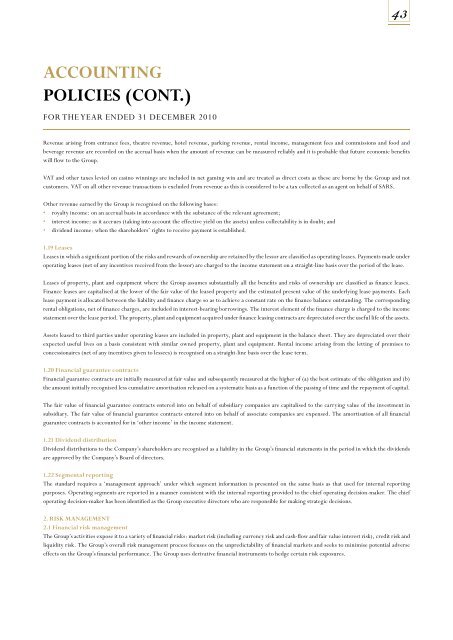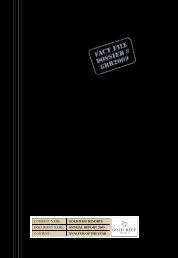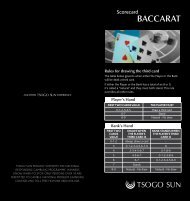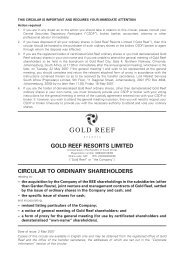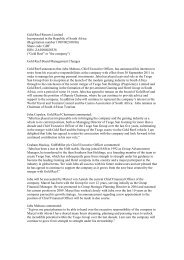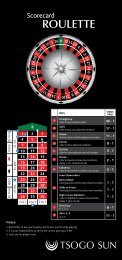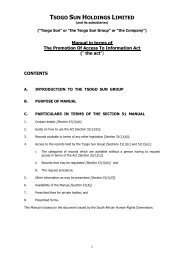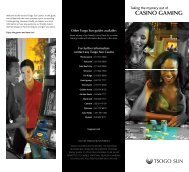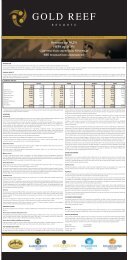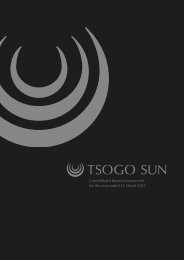ANNUAL REPORT 2010 - Tsogo Sun
ANNUAL REPORT 2010 - Tsogo Sun
ANNUAL REPORT 2010 - Tsogo Sun
Create successful ePaper yourself
Turn your PDF publications into a flip-book with our unique Google optimized e-Paper software.
43<br />
ACCOUNTING<br />
POlICIES (CONT.)<br />
FOR THE YEAR ENDED 31 DECEMBER <strong>2010</strong><br />
Revenue arising from entrance fees, theatre revenue, hotel revenue, parking revenue, rental income, management fees and commissions and food and<br />
beverage revenue are recorded on the accrual basis when the amount of revenue can be measured reliably and it is probable that future economic benefits<br />
will flow to the Group.<br />
VAT and other taxes levied on casino winnings are included in net gaming win and are treated as direct costs as these are borne by the Group and not<br />
customers. VAT on all other revenue transactions is excluded from revenue as this is considered to be a tax collected as an agent on behalf of SARS.<br />
Other revenue earned by the Group is recognised on the following bases:<br />
• royalty income: on an accrual basis in accordance with the substance of the relevant agreement;<br />
• interest income: as it accrues (taking into account the effective yield on the assets) unless collectability is in doubt; and<br />
• dividend income: when the shareholders’ rights to receive payment is established.<br />
1.19 leases<br />
Leases in which a significant portion of the risks and rewards of ownership are retained by the lessor are classified as operating leases. Payments made under<br />
operating leases (net of any incentives received from the lessor) are charged to the income statement on a straight-line basis over the period of the lease.<br />
Leases of property, plant and equipment where the Group assumes substantially all the benefits and risks of ownership are classified as finance leases.<br />
Finance leases are capitalised at the lower of the fair value of the leased property and the estimated present value of the underlying lease payments. Each<br />
lease payment is allocated between the liability and finance charge so as to achieve a constant rate on the finance balance outstanding. The corresponding<br />
rental obligations, net of finance charges, are included in interest-bearing borrowings. The interest element of the finance charge is charged to the income<br />
statement over the lease period. The property, plant and equipment acquired under finance leasing contracts are depreciated over the useful life of the assets.<br />
Assets leased to third parties under operating leases are included in property, plant and equipment in the balance sheet. They are depreciated over their<br />
expected useful lives on a basis consistent with similar owned property, plant and equipment. Rental income arising from the letting of premises to<br />
concessionaires (net of any incentives given to lessees) is recognised on a straight-line basis over the lease term.<br />
1.20 Financial guarantee contracts<br />
Financial guarantee contracts are initially measured at fair value and subsequently measured at the higher of (a) the best estimate of the obligation and (b)<br />
the amount initially recognised less cumulative amortisation released on a systematic basis as a function of the passing of time and the repayment of capital.<br />
The fair value of financial guarantee contracts entered into on behalf of subsidiary companies are capitalised to the carrying value of the investment in<br />
subsidiary. The fair value of financial guarantee contracts entered into on behalf of associate companies are expensed. The amortisation of all financial<br />
guarantee contracts is accounted for in ‘other income’ in the income statement.<br />
1.21 Dividend distribution<br />
Dividend distributions to the Company’s shareholders are recognised as a liability in the Group’s financial statements in the period in which the dividends<br />
are approved by the Company’s Board of directors.<br />
1.22 Segmental reporting<br />
The standard requires a ‘management approach’ under which segment information is presented on the same basis as that used for internal reporting<br />
purposes. Operating segments are reported in a manner consistent with the internal reporting provided to the chief operating decision-maker. The chief<br />
operating decision-maker has been identified as the Group executive directors who are responsible for making strategic decisions.<br />
2. RISK MANAGEMENT<br />
2.1 Financial risk management<br />
The Group’s activities expose it to a variety of financial risks: market risk (including currency risk and cash-flow and fair value interest risk), credit risk and<br />
liquidity risk. The Group’s overall risk management process focuses on the unpredictability of financial markets and seeks to minimise potential adverse<br />
effects on the Group’s financial performance. The Group uses derivative financial instruments to hedge certain risk exposures.


